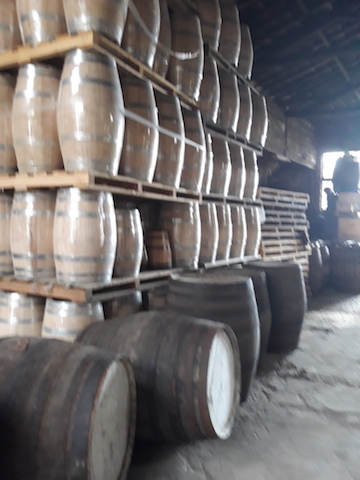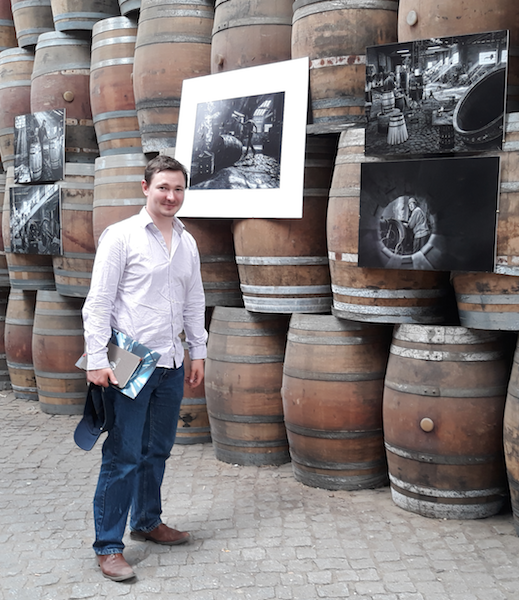Gregor’s Guide To Whisky Maturation
As an independent bottler, cask management and a good wood policy are essential. It is the only way I can potentially add value because I can’t control the distillate.

Oak casks finished
at the Bodega
It is a very important step in the production of good Scotch and 50-70% of the bottled spirits flavour will come from the cask. Cask maturation provides colour, it removes undesirable flavours and the spirit extracts desirable flavours from the oak. Oak contains many sugars! Each year we lose about 3% to evaporation (the Angel’s share) and each year the alcohol level will reduce and if it falls below 40% alcohol it cannot be called whisky.
In Scotland, around 90% of Scotch is matured in ex-bourbon Hogshead casks. Prior to this Sherry Butts were used but the industry changed to bourbon casks in the late 1930s when the US decided that bourbon casks could only be used for the maturation of bourbon once and so this provided the Scotch whisky industry with lots of cheap used oak casks to mature whisky.
Where bourbon matured whisky typically provides that light golden colour spirit with vanilla and coconut flavours, Sherry matured whisky is darker in colour, with more raisin and cherry flavours.
A cask can be used multiple times until it is exhausted which is usually after 40 years. However, the intensity of flavour reduces with each refill. First fill casks are highly desirable, but in my experience when using first fill Sherry casks, it is better to use them for finishing the first time as the oak contains so much sherry flavours that if left in there for a prolonged period of time the spirit can be overpowered. Wine and Port casks are particularly susceptible to overpowering spirit if not carefully managed.
The provenance of the actual oak used to make up a cask is proving to be an interesting field of research. It has been suggested that the fruity flavours derived from a sherry cask are not necessarily due to the fact that the cask previously contained sherry. The reason is also that European Oak is different from bourbon cask oak which is taken from the United States, using a different type of oak which possesses different flavours.

That’s me at the
bodega in Portugal
Last year I visited a bodega in Europe and it is very much like visiting a lumber yard in Scotland, which I did with my Dad as a kid because he was a joiner.
Essentially the bodega will allow the oak to dry outside which has been shown to produce greater colour in the spirit and make for higher quality Whiskies. A company will pay a premium for casks that are constructed from oak that has been left outside to be dried naturally.
Charring is a key process in the construction of a cask. Charring is the process of heating the inside of the cask to burn/char the inside layer, this allows the cask to absorb spirit while degrading a layer within the cask which allows for the release of lignin and thereby vanillin which is a vanilla flavour, the process also adds colour. Typically, a distillery can choose the amount of charring they want and the deeper the charring the more intense the colour. This is why bourbons achieve so much colour so soon as the barrels used are heavily charred as is custom in the US.
The size of a cask will determine the amount of impact the wood will have. The larger the cask the less spirit to wood contact and therefore the less extraction. For example, 50-litre Octaves enjoy a huge amount of wood to spirit contact which results in lots of flavour being transferred to the spirit in only a matter of months. However, the drawback is that too long in this cask and the wood can overpower the whisky. The alcohol strength at filling will impact the extraction of flavour from oak, if too high or low the extract level is very low. For this reason, whisky is usually filled into casks at 63% to 70%.
Generally speaking, the higher the outside temperature, the quicker the oak extraction. Fortunately, Scotland is the ideal temperature to mature whisky so that it is delicately balanced but if the temperature rose significantly then the spirit would retain lots of oak character while retaining the drawbacks associated with an immature spirit such as being strong, pungent and sulphury. In the US and India and other hot climates, the alcohol level will actually increase because the water evaporates quicker than the alcohol.